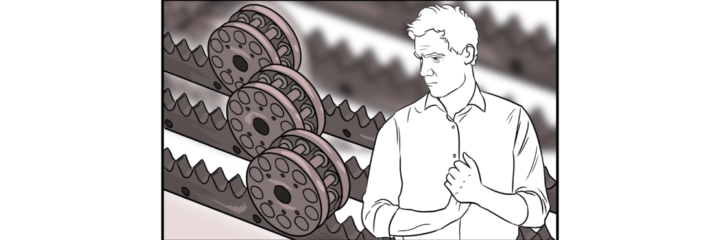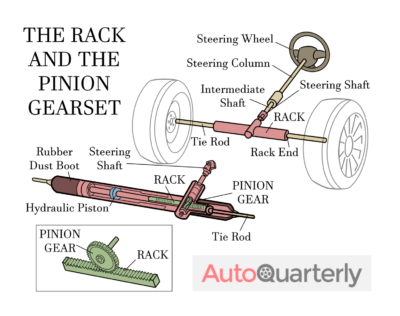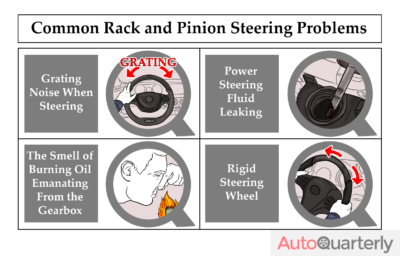Rack and pinion steering is a concept we’ve all heard of, but few of us understand. You’re probably envisioning it as involving some advanced engineering or physics concepts. And you’re right. But you don’t need an advanced degree to understand how it works.
It’s more about the basic mechanics of cars than complicated physics. It’s highly likely that your car has a rack and pinion steering. Even if you’re unaware of it, you’ve experienced it every time you want to take a sharp turn and all you’re required to do is smoothly turn the steering wheel to the direction you want to go.
That right there is rack and pinion steering in action.
Ever wondered how it works? The concept, design and mechanism?
It’s quite a genius invention. Here’s everything you’ll ever need to know about rack and pinion steering.
Let’s jump right in.
What Is Rack and Pinion Steering?
Rack and pinion steering is a mechanism that allows the wheels of a car to rotate as the driver turns the steering wheel. It is the most common type of steering system found on most cars and some small SUV’s. Rack and pinion steering can function with or without power steering.
This steering system enables the driver to have more control over the direction of the wheels while the car is making a turn. Although it has fewer moving parts than larger, conventional steering systems, rack and pinion steering helps to reduce the amount of effort needed to direct the car.
The Rack and Pinion Steering Design
A rack and pinion steering system is made up of a couple of parts. The steering wheel is connected to a steering shaft that is attached to a gear set. The gear set is made up of a rack and a spiral cut pinion that are positioned in an encased metal tube.
The spiral cut pinion is fitted at the other end of the steering shaft and meshes with a horizontal steering rod. The horizontal rod has a toothed middle section called a rack that the pinion gear sits on. On either side of the horizontal shaft are tie rods that attach to ball joints which control the lateral movement of the front wheels of the car.
How a Rack and Pinion Steering Works
When the steering wheel turns, the pinion gear engages the rack and helps the shaft roll with it, moving the parallel bar from side to side, imitating the action of the steering wheel.
By turning the steering wheel, the rack and pinion gear receives the rotating motion energy and converts it into linear motion energy, allowing the wheels of the car to smoothly turn from side to side.
Rack and Pinion Steering Ratios
Have you ever noticed that the front wheels of your car do not point in the same direction when you turn your car around? If both wheels were to point in the same direction, this would cause an uneven turn and loss of tire grip. Every wheel has its own tire radius that it follows, with the inner wheel making a tighter turn than the outer one.
It usually takes about three to four revolutions for the steering wheel to go from lock to lock—that is, from extreme left to extreme right. The steering ratio indicates how far you would have to rotate the steering wheel in order to turn the wheels of the car.
For example, if the car was to make a 360-degree turn, the wheels of the car would have to be turning at about 20 degrees. The steering wheel ratio would be calculated as 360 divided by 20, which gives you an 18:1 steering ratio. If the steering wheel requires more turns to get to the desired angle, that is considered a high steering ratio. A low steering ratio means that the steering wheel has a quicker response or requires fewer turns of the steering wheel to make a complete revolution.
The steering ratio is also determined by the teeth spacing on the rack. Some cars have even teeth spacing all throughout, while others have a variable ratio steering with the teeth being very narrow in the middle of the rack and spaced out wider towards the rod ends that are closer to the wheels.
Sports cars have a quicker response as they mostly use variable ratio steering systems. As such, they typically have low steering ratios compared to and trucks and typical cars.
Power-Assisted Rack and Pinion Steering (Power Steering)
A vehicle with a power steering system has a slightly different design of its rack and pinion set. One side of the rack is fitted with a cylinder that contains a hydraulically-actuated piston in the middle. The piston is connected to the rack and has two fluid ports on opposite sides of the piston.
Depending on the direction the vehicle is being steered in, a rotary valve directs hydraulic fluid to either the left or the right side of the piston. The fluid applies pressure on the piston and reduces the amount of effort needed to move the rack.
Common Rack and Pinion Steering Problems
Grating Noise When Steering
When you start to hear a grinding noise coming from your steering gearbox, it’s an indication of metal-on-metal contact. When you turn left or right, you may hear a scraping or scratching sound. This might be a sign that the rack and pinion system may be in need of lubrication. A good mechanic would be able to fix it, or let you know if you might have a bigger problem with your steering gearbox.
Power Steering Fluid Leaking
When the level of the power steering fluid starts to decrease to an inadequate level, you may notice that it becomes more difficult to turn your steering wheel. A quick fix is simply to check the level of your power steering fluid and top it up. The power steering fluid should be checked regularly. If it is left unchecked for too long, it can cause the steering rack and gearbox to overheat. It could also seriously damage the gears.
The Smell of Burning Oil Emanating From the Gearbox
Have you ever been driving and suddenly smelled something like burning oil? The first thing you should do is stop driving immediately. Power steering fluid does smell like burning oil, and it could be a sign that your gearbox is overheating. Driving the car while the gearbox is overheating can lead to a dangerous fire.
Rigid Steering Wheel
If you find yourself putting in a lot of effort to turn the car to one side, this may be because the steering pump is failing, or the rack may be damaged. The power steering unit may be lacking enough pressure, or the pinion may be jammed on the rack. If this starts happening to you, have your mechanic look at the car to ensure you fix whatever problem is causing the hard turns.
Rack and Pinion Steering Replacement
When the problem persists, you may have to replace the whole system. This is not a big deal at all. Here’s how to easily replace a rack and pinion steering.
- Raise the front wheels of the vehicle with jack stands. Ensure that the jack is placed under the frame rails behind the front wheels. Remember to put a weight behind the rear wheels to prevent the vehicle from rolling back.
- Remove the pinch bolts with a large screwdriver to separate the steering joint between the rack and pinion set from the steering column. Make sure the wheel or column cannot turn when the joint is detached.
- If it’s a power steering system, remove the two power steering hoses with a flare nut wrench. The pipe should not spin with the fitting, but if it does, wet it with penetrating oil and shake it back and forth.
- Measure and write down the distance between the tie rod locknut and the bellows boot on either side of the vehicle. This will come in handy later when putting back the tie rods.
- Loosen the tie rod locknut with an open-end wrench and remove the cotter pin. You can gently tap the sides of the steering knuckle with a hammer to release the tie rod stud.
- Take out the older rack and pinion assembly and compare it with the new one you have to make sure it will fit. You may need to transfer the rack from the old unit to the new one.
- Secure the new rack and pinion unit with the rack mount bolts. Replace old O-rings with new ones and reattach the fluid lines. Connect the input shaft to the steering column and torque the mount bolts.
- Return the tie rod ends at the exact measurements you took earlier and tighten the tie rod locknuts.
- Secure the wheels in place and lower the vehicle.
- If your vehicle has power steering, it is important to learn how to bleed the power steering pump after draining out all the old fluid. Confirm with your vehicle’s repair manual or owner’s manual to establish which fluid would be best for your car.
Final Words
Now you have an idea what happens behind the scenes every time you turn your steering wheel. Rack and pinion steering is a basic concept that has been used world over to help drivers navigate sharp corners. While it’s not one of the most sophisticated processes in car engineering, it’s intriguing what such a simple mechanism can achieve.




